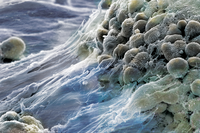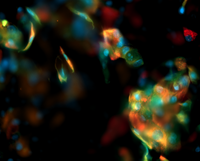Emily Chen, Brendan Harley Lab
Chemical & Biomolecular Engineering
Emily also won the 2018 Challenge.
Where the river goes
Presented is brain tumor cells invading to the brain in a mimetic hydrogel captured with SEM. Glioblastoma is a malignant brain cancer which spreads throughout the brain and leads to poor survival. We develop engineered models to investigate how the tumor microenvironment influences tumor progression and therapeutic outcomes.
Acknowledgement: We acknowledge Cate Wallace and Julia Pollack for their assistance in generating this image.
Mayank Boob, Gruebele and Pogorelov Labs
Chemistry and Center for Biophysics & Quantitative Biology
Two Ways To Fight Pressure
Fish in extreme depth experience a huge amount of pressure. Here are simulation models of two different proteins illustrating two strategies that can help keep a protein stable in extreme environments – making small molecules which act as bubble wrap and crowding a lot of proteins together so that the pressure felt by each one is reduced.
Uzoma Nwabara, Paul Kenis Lab
Chemical & Biomolecular Engineering
A Wave Away
CO2 electroreduction is a technology proposed for combating rising CO2 emissions. The original image, the surface of a silver electrode that was used to reduce CO2 to CO, was taken with scanning electron microscopy. Here, we made a wave by overlapping and recoloring the same image multiple times.
Huei-Huei Chang, Catherine Murphy Lab
Department of Chemistry
Beauty of Our Lung
Confocal fluorescence micrograph of 3D human lung tissue. Human lung epithelial cells were cultured on a porous membrane and further differentiated into diverse cell types. Nuclei (blue) and goblet (green), ciliated (orange) and club (red) cells represent the complex composition and physiological function of human lungs.
Xuan Zhou, Dlott Lab
Department of Chemistry
Metal-organic framework as shock protective material
SEM side-views on a metal-organic framework (MOF) film before (back) and after (front) shock compression. MOF crystals become less damaged as the shock wave (blue flame) travels deeper, due to the weakened shock strength by void compaction and bond-breakage.
SEM images taken at Beckman Institute. Dynamic effects added using Photoshop.
Meredith Rickard, Pogorelov & Gruebele Labs
Department of Chemistry
Chemical Reviews Cover Art
Chemical Reviews, Vol. 119 Issue 18, September 25, 2019
Proteins must navigate the cellular environment in order to perform their biological functions. Interactions with other biomolecules, metabolites, ions and water can be diverse and impact the protein's folding and function in vivo. The image illustrates the crowded complexity of the cell in an all-atom model of the E. coli cytosol.





